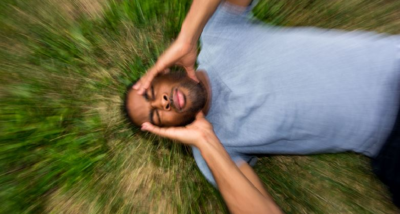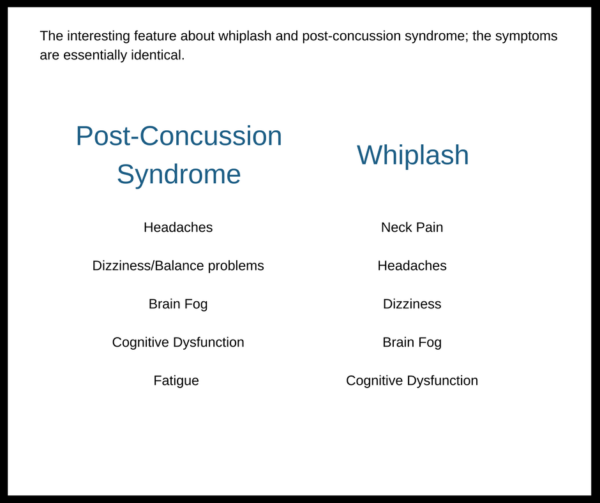Upper Cervical Chiropractic Offers Post-Concussion Syndrome Relief
A concussion is also known as a traumatic brain injury. They can happen during any activity or injury that causes the brain to shift inside the skull. This can cause a bruising of the brain and damage to blood vessels, which lead to common concussion symptoms that can last for 7-10 days. However, many concussion sufferers notice residual symptoms that continue for weeks, months, and even years. At this point these symptoms are now considered post-concussion syndrome.

What Causes Post-Concussion Syndrome
Researchers have found the average concussion requires 100 G’s of force to the head. However, an upper neck injury requires only 4-6 G’s. Since any force that is strong enough to damage the head can also damage the neck, it is estimated that over 90% of concussive head injuries also lead to an upper neck injuries. This type of injury can misalign the top two bones of the spine known as the Atlas and Axis. Misalignment and injury to the upper neck frequently leads to residual symptoms including:
- Headaches / Migraines
- Cognitive Problems (Inability to focus, memory loss, & confusion)
- Difficulty Sleeping
- Dizziness / Vertigo
- Anxiety / Depression
- Neck and Back Pain
It is important to note that even though many concussion sufferers do experience upper neck injuries, there are secondary types of post-concussion syndrome that may not involve the neck.
Why Does Upper Neck Misalignment Lead to Post-Concussion Symptoms
- Altered cerebrospinal fluid (CSF) flow: Researchers have used MRI imaging to study CSF flow to and from the head. What they found were those who suffered an injury to their head and upper neck had a twist or shift of their top neck vertebra, which led to a buildup of CSF in the head. This blockage led to increased pressure and post-concussion symptoms.
- Brainstem interference: The brainstem is a vital bundle of nerves which pass through the upper neck vertebra, also know as the Atlas and Axis. Since these nerves directly connect to the brain, they are responsible for many essential life functions. Interference here may easily lead to pain and other symptoms.
- Restricted blood flow: Brain imaging has shown the cranial blood flow changes that take place following a head or neck injury. When injury causes upper neck misalignment, some brain centers may experience areas with a lack of oxygen, while other areas experience increased brain pressure. This is thought to be one of the leading causes of post-concussion syndrome.
Signs Your Post-Concussion Symptoms are Stemming from an Upper Neck Problem
Few concussion sufferers are aware of the similarity of symptoms between post-concussion syndrome and whiplash. These two conditions have such similar side-effects because they both involve injury to the upper neck. Here is a list of symptoms that indicate your post-concussion syndrome is likely stemming from a correctable, upper neck problem.
- Pain localized to the neck and occipital regions
- Headache pain that is precipitated or aggravated by specific neck movements or sustained head position
- One or more of the following
- Loss of neck mobility
- Uneven neck muscle tone
- Tenderness of neck muscles
- Tilting of the head or neck
- Forward leaning head position
- X-ray or MRI revealing
- Loss or reversal of neck curvature
- “No pathology” (X-ray and MRI images are primarily taken to rule out fractures, lesions, and disc herniation. In many cases, when an X-ray or MRI report reveal “no findings”, it means there is an upper neck misalignment responsible for the unresolved symptoms.)
Hope for Concussion Sufferers
The NUCCA organization has specially trained doctors to correct the misalignment of the upper cervical spine, including those that lead to post-concussion syndrome. If you haven’t heard of NUCCA Upper Cervical Care, that is because there are only 250 trained NUCCA doctors in the entire United States. So what makes this care different from general chiropractic?
- Extremely gentle corrections. When a NUCCA doctors makes a correction to the spine, a light and controlled pressure is focused on the upper spine, in just the right direction and depth. It is completely painless.
- NUCCA is highly precise. NUCCA utilizes mathematics and biomechanics to accommodate each patients “SPECIFIC” needs. Exact measurements are taken to tailor the correction to each patient.
- Long-Lasting Results. Upper cervical care is designed around healing and recovery. As problem or damaged areas begin to heal and recover, corrections and relief last longer as well. This means far less frequent health visits.
To find a NUCCA doctor near you, visit NUCCA.org. Or to speak with one of our NUCCA Chiropractors in Eatontown, New Jersey, click the button below to schedule your complimentary concussion consultation. While scheduling your consultation, you will have the opportunity to speak with one of our doctors about your particular symptoms.
Molland Spinal Care doctors are Eatontown Upper Cervical Chiropractors trained by the National Upper Cervical Chiropractic Association (NUCCA). Our NUCCA Clinic has helped many people find natural relief from post-concussion syndrome in Eatontown, New Jersey. As NUCCA Chiropractors we are uniquely trained to correct problems in the Upper Cervical Spine (upper neck). This vital area is intimately connected to the central nervous system and problems in this area have been shown to be an underlying cause of a variety of different problems. More information can be found on our website at https://www.mollandspinalcare.com
Resources and Helpful Links
- Post Concussion Syndrome Journal
- Cameron MM, Vernon H, et al. The Role of the Cervical Spine in Post-Concussion Syndrome. The Physician and Sports Medicine. 2015.
- Mild Traumatic Brain Injury Jouranl
- Ellis, Leddy, Wiler. Physiological, vestibule-ocular, and cervicogenic post-concussion disorders: an evidence-based classification system with directions for treatment. Brain Injury. 2014.
- Sports Medicine Journal on Concussion
- Leddy J. Brain or Strain? Symptoms Alone Do Not Distinguish Physiologic Concussion from Cervical/Vestibular Injury. Clinical Journal of Sports and Medicine.
- Mayo Clinic
- NUCCA Association



